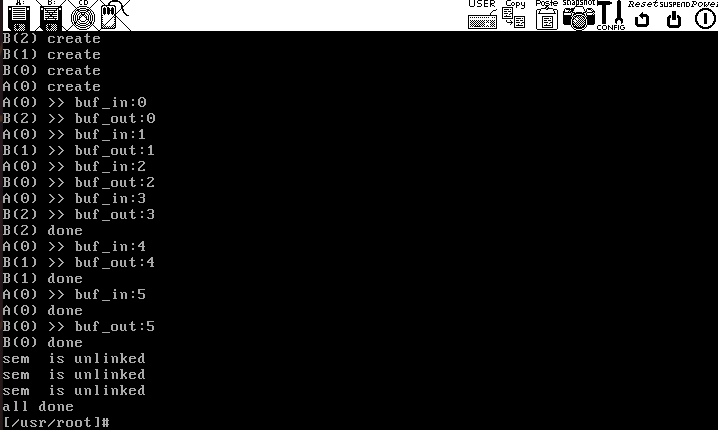HIT-OSLab5
实验目的:
- 加深对进程同步与互斥概念的认识
- 掌握信号量的实现原理两种(不同的实现方式)
- 掌握信号量的使用,并应用它解决生产者-消费者问题
实验内容:
- 在 Linux-0.11 中实现信号量,具体来说就是实现如下4个系统调用:
- sys_sem_open:用于打开一个信号量文件描述符
- sys_sem_wait:等待一个信号量的释放
- sys_sem_post:释放一个信号量
- sys_sem_unlink:删除一个信号量
- 在 Ubuntu 下编写程序,用已经实现的信号量解决生产者-消费者问题
实验过程
进程同步与互斥是操作系统中实现进程间通信和同步的基本机制,它们的主要目的是确保在多个进程之间共享资源时,能够正确地保持同步状态,避免竞争条件和数据不一致等问题
- 进程同步是指在多个进程之间同步数据访问,确保同一时刻只有一个进程可以访问共享资源
- 进程互斥是指在多个进程之间同步对共享资源的互斥访问,确保同一时刻只有一个进程可以访问共享资源
进程同步和互斥可以通过不同的同步原语来实现,例如:锁(Lock)、信号量(Semaphore)、条件变量(ConditionVariable)
- 锁:有两种实现方式,基于原子操作和基于信号量
- 信号量:核心结构为一个整数和一个等待队列
- 条件变量:在满足特定条件时通知进程,使其可以访问共享资源
PV 操作是指进程之间的同步原语,用于实现进程之间的同步和通信(PV 操作是 Posix 信号量的一种实现方式)
- P操作:信号量 —,判断是不是要阻塞
- V操作:信号量 ++,判断是不是要唤醒
PV 操作的实现需要保证操作的原子性,而保证原子性有很多方法:
- 这里不采用软件保护法(比如:轮换法 \ 标记法 \ peterson 算法 \ Lamport 面包店算法),而是采用硬件保护法
- 由于是 linux-0.11 运行在单核 cpu 上(Bochs 虚拟机提供单核 cpu 环境),所以可以采用简单的开关中断的方法
- 如果是多 cpu 环境,就使用硬件原子指令保护法(用硬件原子指令操控一个 mutex 信号量来保护临界区)
开关中断的实现需要依赖如下函数:
1 |
基于 PV 操作实现信号量的模板如下:
1 | P(){ |
- 信号量 > 0 时,信号量代表临界区中拥有的资源数目
- 信号量 < 0 时,信号量代表等待队列中的进程数目
本实验要求我们实现信号量,定义信号量的数据结构如下:(在 /include/unistd.h 中)
1 |
|
wait_tasks[QUE_LEN]为静态列表,索引 front / rear 分别表示其头部 / 尾部的位置
首先我们需要添加信号量的系统调用号:(在 /include/unistd.h 中)
1 |
- 需要注意的是:这里同时需要修改
hdc-0.11.img中的hdc/usr/include/unistd.h文件,如果想在虚拟机中使用 gcc 编译的话,会导入虚拟机hdc/usr/include/中的文件为头文件
接着修改系统调用号的总数:(在 /kernel/system_call.s 中)
1 | nr_system_calls = 76 |
最后添加新的系统调用定义:(在 /include/linux/sys.h 中)
1 | extern int sys_sem_open(); |
头文件以及全局变量:(在 /kernel 中新建文件 sem.c)
1 |
|
基础字符串函数:
1 | int strcmp_sem(char* name,char* tmp){ |
插入 / 获取 task_struct 结构体:
1 | struct task_struct * get_task(sem_t* q) |
- 使用静态队列 FIFO
系统调用 sys_sem_open:打开一个信号量文件描述符
1 | int sys_sem_open(const char* name,unsigned int value) |
系统调用 sys_sem_wait:P 操作
1 | int sys_sem_wait(int i){ |
系统调用 sys_sem_post:V 操作
1 | int sys_sem_post(int i) |
系统调用 sys_sem_unlink:删除一个信号量文件描述符
1 | int sys_sem_unlink(const char *name) |
修改 makefile:
1 | OBJS = sched.o system_call.o traps.o asm.o fork.o \ |
实验的最后我们需要使用信号量来解决生产者-消费者问题
消费者模型是一种用于描述消费者行为和系统性能的模型:系统中有一组生产者进程和一组消费者进程,生产者进程每次生产一个产品放入缓冲区,消费者每次从缓冲区中取出一个产品并使用,生产者、消费者共享一个初始为空、大小为 n 的缓冲区
- 只有缓冲区没满时,生产者才能把产品放入缓冲区,否则必须等待
- 只有缓冲区不为空时,消费者才能从中取出产品,否则必须等待
- 缓冲区是临界资源,各进程必须互斥的访问
生产者-消费者模型代码如下:
1 |
|
最终效果如下:
